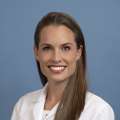October is , during which women can celebrate the progress made in recent years in screening and treatments. These advancements have dramatically improved survival rates — up to 99% for cancer that has not spread outside of the breast.
Doctors attribute part of that progress to movement away from a “one size fits all” approach to breast cancer screening that involves mammography, starting at age 40, that prevailed beginning in the 1980s.
“In recent years, we’ve started to take a more personalized approach to breast cancer screening,” said Carlie K. Thompson, MD, assistant professor of surgery and a breast surgical oncologist at UCLA Health and the UCLA/Revlon Breast Center. “We consider a woman’s age and risk factors when determining the best screening regimen for her.”
Additional advancements have been made in the areas of genetic testing and breast imaging. Expanded panel genetic testing, which looks for changes in an individual’s genes that may be associated with an increased risk of developing certain types of cancer, is more accessible than ever, and digital breast tomosynthesis, also known as 3D mammography, has become more mainstream. Breast MRI and breast ultrasound are helpful adjuncts to mammography for certain subpopulations of women.
Potential Risk Factors
One potential risk factor for breast cancer is dense breast tissue, a condition that can be determined only with a mammogram. Nearly half of women have dense breast tissue, said Dr. Thompson, a member of the . Dense breast tissue is not only a risk factor for breast cancer, but it also can make breast cancer harder to detect on routine screening. Although having dense breast tissue in and of itself is unlikely to put a woman into the highest risk category for developing breast cancer, it can serve as an impetus for discussions with their physician regarding breast cancer risk, screening and risk reduction.
“This is what risk stratification in breast cancer is all about: using known risk factors, such as family history, genetic mutations, a woman’s personal history of breast disease, lifetime exposure to hormones and breast density to help us define a strategy for screening and risk reduction,” Dr. Thompson said.
Doctors use a system called the Breast Imaging Reporting and Data System, or BI-RADS, to describe mammogram findings and results. The system includes four categories for breast density: A (almost entirely fatty), B (scattered areas of fibroglandular density), C (heterogeneously dense) and D (extremely dense).
According to , 38 states and the District of Columbia require some level of breast density notification after a mammogram. Since 2013, the California Breast Density Notification Law has required that imaging facilities notify patients whose mammograms show that they have dense breast tissue. This is the required wording: “Your mammogram shows that your breast tissue is dense. Dense breast tissue is common and is not abnormal.”
However, “research has not yet shown that changing a woman’s breast cancer screening recommendations based solely on breast tissue density makes a difference in mortality,” Dr. Thompson said. “Therefore, we don’t tend to add more screening studies based on breast density alone.”
Concern over false positives
Another reason doctors are thoughtful about what breast cancer imaging studies should be done for each individual patient is the risk of false positives. Breast imaging modalities have become so good, Dr. Thompson said, “that there is a risk of picking up more and more background noise, especially in women with dense breast tissue.” This can lead to additional workups and biopsies that ultimately prove to be negative.
Doctors find themselves walking a fine line. Overdiagnosis and overtreatment — with the accompanying cost and stress for patients and their families — are significant issues.
The good news is that more personalized screening programs have helped doctors catch breast cancers earlier, allowing them to initiate life-saving methods sooner, Dr. Thompson said. UCLA Health continues to seek answers through the WISDOM Study, a nationwide, multi-institution effort. The , which began several years ago, is assessing tens of thousands of women across the country to attempt to find the best and safest way to screen for breast cancer. This month, the study is expected to open to women who are 30 to 39 years old.
“Breast cancer in women younger than 40 is relatively rare, but the risk of false positives is high,” Dr. Thompson said. “We know there are populations of women under age 40 who are at risk, including genetic mutation carriers and women with strong family histories. The goal of the 30-to-39 bracket is to identify women in this age range at higher risk so that we can start screening them earlier.”
Martha Groves is the author of this article.




